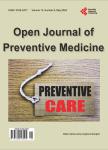Factors associated with intention to undergo specific health guidance among Japanese workers using health belief model
Factors associated with intention to undergo specific health guidance among Japanese workers using health belief model作者机构:Graduate School of Humanities and Sciences Ochanomizu University Tokyo Japan
出 版 物:《Open Journal of Preventive Medicine》 (预防医学期刊(英文))
年 卷 期:2012年第2卷第2期
页 面:183-189页
学科分类:1002[医学-临床医学] 100214[医学-肿瘤学] 10[医学]
主 题:Patient Participation Health Belief Model Net Benefit Japanese Health Guidance
摘 要:Objectives: To examine the factors associated with the intention to undergo “specific health guidance. Methods: Self-reported questionnaire data were collected from 4861 health insurance union members of a company in Japan from August to September 2010. The information gathered included the intention to undergo “specific health guidance, the Health Belief Model (HBM) subcomponents (perceived severity, susceptibility, benefit, and barriers), other factors related to undergoing specific health guidance, sex, and age. Perceived threat and net benefit were the main HBM components. Bivariate and multivariate logistic regression analyses were used to assess the associations between intention and the main HBM components, i.e., perceived threat and net benefit. We used two models with intention as the dependent variable;Model 1 used four HBM subcomponents, and Model 2 used perceived threat and net benefit as independent variables. Results: A total of 3457 individuals answered all variables (response rate;71.1%). Perceived severity (OR: 1.83, 95%CI: 1.59 - 2.10), benefit (OR: 6.91, 95%CI: 5.94 - 8.04), barriers (OR: 0.11, 95%CI: 0.09 - 0.13), perceived threat (OR: 1.52, 95%CI: 1.31 - 1.76), and net benefit (OR: 11.28, 95%CI: 9.60 - 13.25) were related to intention (all p 0.01). Multivariate analysis showed that net benefit (OR: 11.23, 95%CI: 9.55 - 13.20) had a stronger correlation with intention than did perceived benefit (OR: 4.67, 95%CI: 3.95 - 5.51) and barriers (OR: 0.15, 95%CI: 0.13 - 0.18) (all p 0.01). Conclusions: The results suggested that the main HBM components may predict health behavior better than the subcomponents. These results may effectively promote the benefits of, and reduce barriers to, programs aiming to increase participation in specific health guidance.



